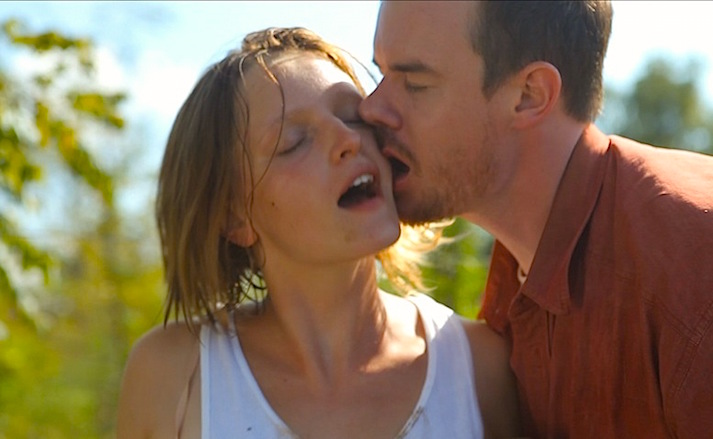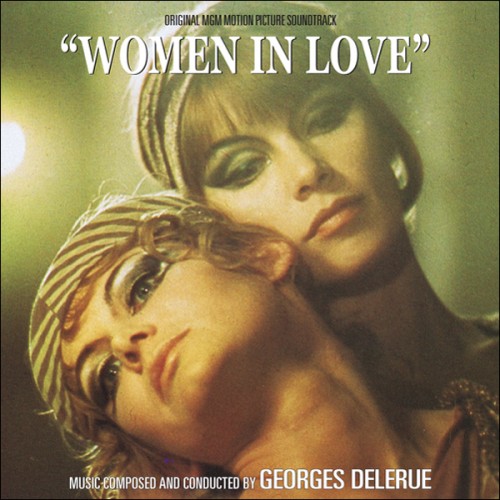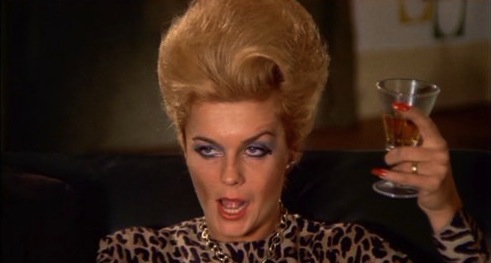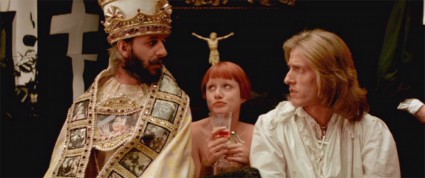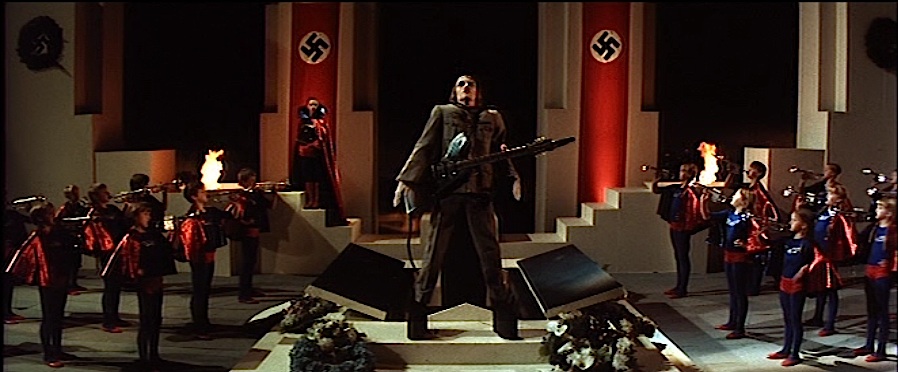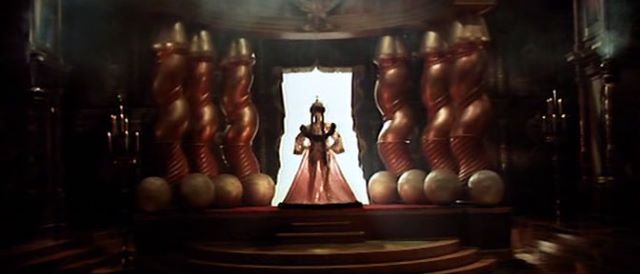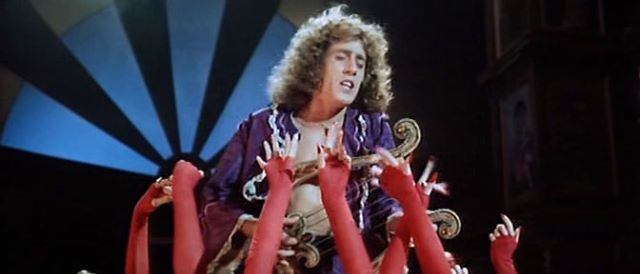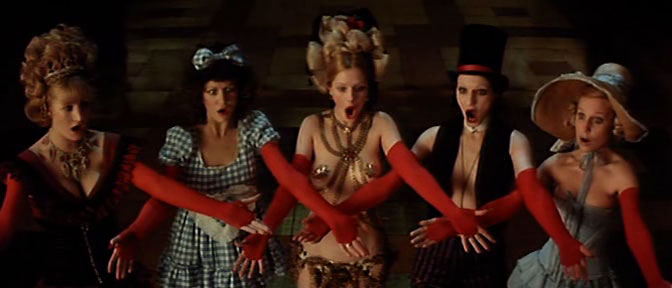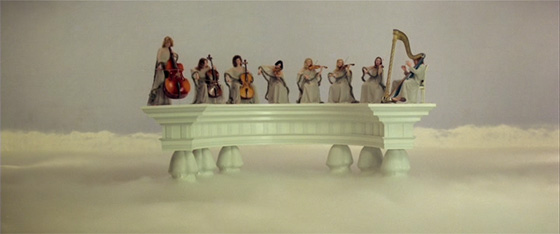The first time I noticed Josephine Decker was when she appeared as an actor in Joe Swanberg’s 2011 film, Uncle Kent. It is a great film and it gained a great deal as soon as Decker walked into Swanberg’s frame. Realistic, casually beautiful and charismatic — Josephine Decker made an impression.

Artist, Josephine Decker. Image from project for The School of Making and Thinking with Adriana Disman
It didn’t take me long to discover her first documentary feature, 2008’s Bi the Way (co-directed with Brittany Blockman) and her solo documentary, 2010’s Squeezebox. She went on to act in two more Swanberg projects in 2011. Not to mention that she also created a video for Charlie Hewson’s song, Where Are You Going, Elena? which incorporated animation by Matt Monson. But it was in her 2012’s Me the Terrible short, that seems to have actually begin to find her unique cinematic voice.
When I first saw Josephine Decker’s first feature length film, 2013’s Butter on the Latch, it wasn’t just revelatory — it was a metaphorically saturating adventure from which presented me with a challenge to reorient myself to step out of the theater and back into the remainder of the day. Emerging out of a sort of dazed state and gradually regaining my grounding, this potent film gave me more than a fair share of food for thought. It haunted me. It would take another viewing — this time on a big screen television — before I could allow myself to grasp what Butter on the Latch was actually about. That statement is not intended to be taken as a negative, but a very positive statement regarding a layered and challenging example of Film Art at it’s most experimental. Over a year later I had the opportunity to see her next film and my initial opinion of this filmmaker’s work felt validated.
Josephine Decker’s two films are more of a “cinematic experience” than simply getting lost in a movie’s narrative or style. Once these two films start, you have no choice but to enter Decker’s worlds. I find both films to be equally hypnotic in their ability to pull me in.

Sarah Small and Isolde Chae-Lawrence following the calls of music and lore in Butter on the Latch. Josephine Decker, 2013 Cinematography | Ashley Connor
Josephine Decker’s Butter on the Latch offers a unique perspective regarding the ways society, culture, folklore, music, dance, singing, desire and creativity impact not only a friendship but the formation of identity. It would be far too easy to call the film an adventure into the psyche of friendship or an emotional break. I also find comparisons of her work to that of David Lynch almost offensive. Thanks to what appears to be an artistically shared aesthetic with her cinematographer, Ashley Connor, Decker skillfully creates a world that sometimes looks and seems “real” — but is ultimately shifted into a disarmingly “unreal” space.
For me, the plot of Butter on the Latch is secondary to the way Decker constructs the world in which it evolves. For a film that runs under 80 minutes in length, the movie itself feels far shorter. That is a rare occurrence. In the last decade or so we have seen average film lengths span far longer than necessary. Challenging and artistic cinematic work normally requires patience from the audience. Josephine Decker’s film is never rushed or slow in pace. Intensity and intimacy are so cleverly fueled throughout the movie that she is often able to slow the pace without the audience noticing. Within only a few minutes, Butter on the Latch drops us into what is clearly NYC. Or, more probably Brooklyn. It is within those first few moments that a cleverly edited one-sided cell phone call conversation morphs this artistically thriving and socially active city into a sexually menacing and dangerously intense space. Then, without warning, we find ourselves on the road in what is clearly The Bay Area of Northern California.

Sarah Small walking into the familiar but losing the trail into the unknown aspects of nature and human connection. Butter on the Latch, Josephine Decker, 2013. Cinematography | Ashley Connor
Although it is never clearly stated, it is clear from Decker’s use of POV that we are joining our protagonist into a beautiful space of a folk culture inspired festival and workshops. And while it is clear our two main characters are reuniting within the context of a communal event. This is a gathering to celebrate Balkan culture and folklore in what I suspect is the Mendocino Folklore Camp. Any known perceptions of this community are quickly challenged. Decker’s use of folklore, storytelling, ancient music and dance fuel the film forward into a world of dread and ever present threat that is hiding just a bit further into the woods of this mystical world.

Sarah Small and Isolde Chae-Lawrence following the calls of music and lore in Butter on the Latch. Josephine Decker, 2013 Cinematography | Ashley Connor
When Sarah asks her friend, “Why aren’t you giving me any specifics?” — Isolde seems to either side-step or dismiss this question in a manner that simultaneously feels realistic and passively annoyed. There is a consistently odd mix of concern and indifference that puts not only Sarah, but us in the uncomfortable position of having to cautiously trust Isolde. As Sarah and Isolde attempt to re-connect Isolde shares a recent massage experience that is filled with erotic pleasure but veers so far into male domination / manipulation of Isolde’s body that her reason for sharing her experience almost seems that she is trying to eroticize a sexual violation. All the more alarming, she gives Sarah the name of the “masseur” and urges Sarah to seek the same experience.

“Oh, you know that place…”
Sarah Small and Isolde Chae-Lawrence in Josephine Decker’s Butter on the Latch, 2013. Cinematography | Ashley Connor.
This brief interaction of two young women chatting feels “realistic” but loaded with subversive intent. These two women appear to be fully empowered and sexually confident, but it is here that Decker’s film twists conventional ideas around “girl’s talk” to pull us into an ever-growing threat of predatory dangers.

“What is that drink called again?” Isolde Chae-Lawrence drinks it all down in Josephine Decker’s Butter on the Latch, 2013. Cinematography | Ashley Connor
Decker’s masterful manipulation of surroundings of nature, music, dance, and Connor’s stunning cinematography in the editing process creates a tone that refuses to become official “Surreal” but is powerfully disorienting. Josephine Decker creates a very specific world in order to pull us into a reworking of Balkan folklore. The actual shifting point comes quite early as both friends enter an almost hallucinatory state of drunken confusion. While it appears to a be shared journey into an ancient culture and self-awareness is largely Sarah’s lonely trek into unknown realms of nature and female humanity.

“I don’t know where we’re going.” Josephine Decker’s Butter on the Latch, 2013. Cinematography | Ashley Connor
The deeper Sarah steps into understanding and mastering the Balkan manner of chanting and music to express the culture’s ancient folklore as a tool of connection to the past to form a shared experience in the present — the more feelings of desire, loneliness and isolation seem to mount. What is initially so beautiful is deconstructing into something laced with intensely with madness.

The menace of dark magik and madness are hiding the woods of Mendocino. Butter on the Latch, Josephine Decker, 2013. Cinematography | Ashely Connor
Sarah reads an example of Balkan Folklore about a young maiden who is stolen away by a dragon. To escape the dragon, the beautiful maiden concocts a magical potion which will force the powerful dragon into a deep sleep so that she can escape. It is read in a relaxed way with Sarah pointing to the charm of ancient stories. Isolde seems to be slipping into a deep slumber herself and mutters this will be her bedtime story. Later, a good-looking and gentle musician is spotted by Isolde. Sarah takes notice and is immediately attracted to him. Isolde dismisses the man’s appearance and conduct. Isolde appears to be upset, but fails to communicate it. Instead they both drink excessively. The two friends lose their way back to their cabin. Isolde seems to become more than frustrated with Sarah. Blaming her for getting them lost, she storms away into the darkness. Is Isolde angry because she is interested in a man? Or, is she angry because she blames Sarah for getting them lost? Is it jealousy? Is it frustration? Or, is Sarah just confused? It is a point that is never really fully understood. But Sarah wakes the next morning in a panic. She seems to scramble to flee the cabin. It almost feels as if she is running away from something. After calming down, Sarah begins to proactively pursue the man, the tension mounts over the relationship between the two women. Or, does it?
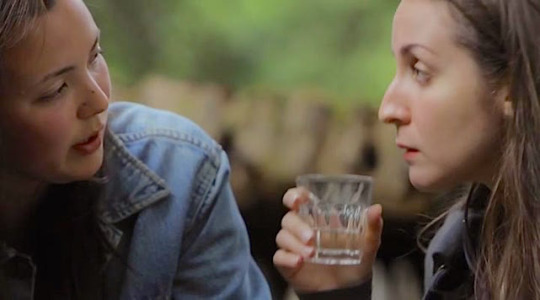
Isolde Chae-Lawrence and Sarah Small in Butter on the Latch, Josephine Decker , 2013
Cinematography | Ashley Connor

Sarah Small and Charlie Hewson flirt in Josephine Decker’s Butter on the Latch, 2013. Cinematography | Ashley Connor.
As tensions mount and Sarah’s advances toward the musician are reciprocated, Sarah’s perceptions start to become less trustworthy. There is a vague sense that she feels she is being pursued by something in the woods. Is it a dragon? Is it Isolde? Is it madness waiting out there? Has Sarah lost the ability to perceive the difference between reality and fantasy? Is she dealing with some sort of disorder? Fantasy Prone Personality, perhaps? Or is her paranoia real? Or is she simply worn out and lost in the mystical beauty of music and folklore?

Sarah Small and Charlie Hewson at the lake. Butter on the Latch, Josephine Decker, 2013 Cinematography: Ashley Connor
When Sarah and the musician disrobe, the truly beautiful eroticism they start to share becomes foggy and takes a disturbing turn. Sarah senses the presence of the threatening menace hiding just beyond her view in the trees. The film arrives to a disturbing conclusion that is vague. It is also a conclusion which is surprisingly satisfyingly. This is cinematic magic.

“What is that? Did you hear that?” Sarah Small in Butter on the Latch, Josephine Decker, 2013. Cinematography | Ashley Connor
Butter on the Latch is distinctively unique from every perspective. Most importantly, it is a fascinating experience that should not be missed. As good as it is, Josephine Decker’s evolution as a filmmaker progresses to a whole other level with her second feature length film, Thou Wast Mild and Lovely.
It is almost impossible to imagine the the budget for her second film was just over $18,000.00. There is nothing about Mild and Lovely that looks “micro-budget” — it has the polish and glow of major studio production. Any comparisons to major studio films ends there. Though Josephine Decker has stated that Steinbeck’s East of Eden influenced several elements of the movie, other critics have compared it to Flannery O’Connor and Terrence Malick. And of course, the sad state of Film Criticism / Film Theory that automatically point to David Lynch at the slightest hint of “something weird” or “stylistically perverse” — an over-used comparison. It is usually an incorrect comparison. I think it is particularly incorrect to compare this film to David Lynch. To be honest, I can only grasp a little bit in Mild and Lovely that might have been inspired by Steinbeck. If you were to pin me in a corner and demand a comparison, the only comparisons that might be valid would be Louis Malle’s Black Moon — a sluggish but lushly experiment in Surrealism as a statement of political unrest. Or maybe some elements employed by Roman Polanski in his adaptation of Roland Topor’s The Tenant. But this constant need to compare one artist to another is usually pointless. It is especially pointless in the case of Decker’s Thou Wast Mild and Lovely.

Sophie Traub is Sarah in Josephine Decker’s Thou Wast Mild and Lovely. Cinematography | Ashley Connor
One should not forget to remember that this film was made by a female artist and is largely concerned with a female character who serves as a sort of narrator throughout the movie. Josephine Decker continues her exploration of ideas nature and the role it plays in the ways humanity connects to form identity, family, lovers, community and often form into subcultures that oppose the way culture/society tries to pre-determine. Once again, Josephine Decker displays an extraordinary way of taking the familiar and bends it all into something we have never seen before. Decker employees Ashley Connor’s beautifully lush off-kilter camera work along with unexpected POV’s, editing, sound and the fascinating charisma of her actors to form a more conventionally structured narrative than she presented in Butter on the Latch.
Decker has secured a group of more professionally skilled actors. While Sophie Traub is the least known actor involved, her performance is an exceptional display of technique. This actor knows what she is doing and brings Decker’s dialogue to life. Many of Sarah’s lines and actions could easily lead an actor toward cliche and even “camp” — Traub is so invested in her role that the deep-rooted sadness and damage find their way into every movement and glance. It is a nuanced portrait of an intelligent but stunted woman. Joe Swanberg, a visionary Independent Filmmaker and a capable actor succeeds in capturing a seemingly beaten-down and depressed man. He seems to want to hide not only the truth of his life, but his sexual impulses. Swanberg’s Akin is brooding a mixture of desire and violence that serves as an uncomfortable threat to both of the other characters.
But viewer beware: there is nothing “conventional” about this film. But the most potent actor here is Robert Longstreet. Longstreet carries a great deal of “cred” within the Independent Filmmaking scene. His talent, abilities and charisma can’t be beat. As Jeremiah he presents an unsettling and often horrific performance. We are never fully allowed access the secret that bonds him so closely to Sarah, but thanks to Longstreet’s mix of amiable redneck and a consistently cruel tension — we know that the secret must be horrific. And, it is most likely still alive under the barn. Decker is joined by both David Barker and Steven Schardt as co-editors and the film’s pace and perspectives are even more effective here than in Butter on the Latch.

“My lover knows how to love me. But things kept getting in the way.” Josephine Decker’s Thou Wast Mild and Lovely, 2014
Cinematography | Ashley Connor
Thou Wast Mild and Lovely is a fresh and constantly innovative take on the Modernist idea of American Gothic. Firmly rooted in Art Horror genre, there is a great deal more here than meets the eye or the expectations related to both of these styles. The film is structured by ever changing visual perspectives — often we see this world reflected from the perspective of animals on the farm. The world of this American farm is lensed from perspectives of a goat, other times a dog or hog take over to provide our restricted view into the intimacies of the humans who are working and living within the confines of this world.
The other narrative device Decker provides is Sarah’s voice reading her poetry. Sarah’s writing is fixated on her ideal lover. Cryptic and romantic, her free form poem carries us throughout the story. And once again, a familiar type of construction that becomes more insightful as we move forward. Sarah offers clues into not only her desires, but into her fractured view of her world. In many ways, she is still a child. But her sexual desires for Akin is almost boiling over. It is due to her stunted emotional development that she is often unaware of the way she presents herself to Akin. Like a child, she often appears to not understand when she exposes something sexual because one suspects no one has ever been there to guide her.

Prepping the lettuce. Thou Wast Mild and Lovely, Josephine Decker, 2014
Cinematography | Ashley Connor
In one of the film’s most disturbing moments, Sarah attempts to seduce Akin. Her mode of seduction is almost as unsettling as where it leads. Covered in mud and sweat, she pursues the opportunity to catch a frog after Akin admits to having a deep dislike of reptiles.

“Bad Froggie!” Sophie Traub in Thou Wast Mild and Lovely. Josephine Decker, 2014
Cinematography | Ashley Owen
She plays with the frog in a childlike-sexual manner and without any warning she gleefully resorts to animal cruelty in hopes of attracting Akin. Just as unexpected, Akin does respond. But this is not lust or desire, this is rape. Akin assaults Sarah with cruel force. But the response of his sexual violence appears to disappoint Akin as much as it unsettles the audience.
Sarah’s perception of sex is either learned from the animalistic nature she has seen on Jeremiah’s farm or is alarming masochistic based on whatever secret has bound her to Jeremiah. While Sarah freely calls Jeremiah “Daddy” — it doesn’t take him long to inform Akin that he is not her father. Their are moments of what appears to be love between Jeremiah and Sarah, but never without an underlying tone of danger and doom.

Robert Longstreet and Sophie Traub in Thou Wast Mild and Lovely. Josephine Decker, 2014
Cinematography | Ashley Connor
Just as soon as you suspect you might have determined the ingredients of Josephine Deckers oddly beautiful but phantasmagorical brewing stew of human tragedy, she creatively throws us off-course. The truth of what may or may not be waiting beneath the barn remains unknown.
This is film so comfortably committed to itself, it offers no easy “out” or clear conclusion. Its power will haunt you long after you experience it.
The buttons have been pushed and the envelope has fallen off the desk, but it is impossible to look away or dismiss Thou Wast Wild and Lovely. Josephine Decker has crafted a world that pulls you in and holds you tight until the credits roll. The one thing that you can be sure of — there is no room for a “neutral” response to this film art. One will either love or hate it. I loved it.

Filmmaker Josephine Decker exploring the senses. Photograph | Adriana Disman from The School of Making and Thinking.
I can’t wait to see what world she creates next.








